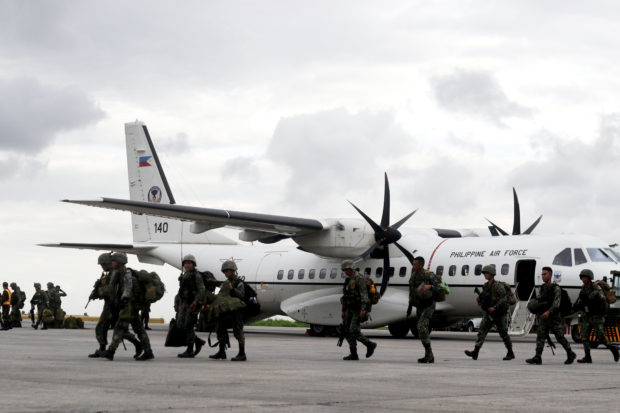Why it took 5 months to end Marawi siege

HOME FROM MARAWI Hundreds of Philippine Marines arrive at Villamor Air Base in Pasay City on Saturday after months of fighting in Marawi City. RICHARD A. REYES
MARAWI CITY — Soldiers lacked training and equipment for urban warfare which stretched the military campaign to rid the city of Islamic State (IS) followers to five months, according to a key ground commander here.
Col. Romeo Brawner Jr., deputy commander of the military’s Joint Task Group Ranao, said officers had to improvise in terms of deploying troopers, equipment and using tactics to defeat members of homegrown terror groups Abu Sayyaf and Maute, who had tried to establish an IS base in this predominantly Muslim city.
The government had declared the liberation of the city from IS, although fighting continued to finish off what the military now refers to as “stragglers,” or remnants of Abu Sayyaf and Maute, still holed up in the city.
Brawner said that despite the shortcomings in equipment and training, improvisations had led to key accomplishments that included the killing of IS leaders — siblings Abdullah, Madie and Omar Maute and IS Southeast Asia “emir” Isnilon Hapilon of Abu Sayyaf.
900 terrorists dead
Article continues after this advertisementTerrorist casualty had reached 900 as of Saturday while the government lost 164 policemen and soldiers. At least 1,700 other government forces had been injured, mainly from improvised explosive devices and sniper fire.
Article continues after this advertisement“We have learned so many lessons here,” Brawner said. “We never had experience in urban warfare. We were trained on jungle warfare but we did our best,” he said.
A ground commander, who talked on condition of anonymity, said soldiers had expected to fight in forested areas but came to realize that they were to engage in close quarter battles in buildings and tunnels.
“We came to realize that our training was not appropriate,” the commander said.
“We were trained to fight in the jungle and in the mountains. Now here comes this situation where we had to take down enemies amid the maze of buildings dotting narrow streets,” the commander said.
He said that in the initial assault by government forces in an inner part of the city, he had ordered mortars fired but realized that these were not effective.
“We intended to surprise the enemies but we were the ones surprised in the end,” he said.
“The exploding mortar shells barely made a dent on buildings because these had been fortified. Hollow blocks were rarely used in construction of buildings here. Those were made of solid concrete,” the commander added as he pointed to a row of buildings that soldiers had retaken after more than three months of fighting since June.
Improvisation
“In the end, we did it but so much improvisation had been used. I just can’t say what these were,” the commander said.
Brawner said the lessons that the war in the city offered would be eventually part of the military’s training manual.
“We will have to amend our doctrine,” Brawner said. “We have to retrain our soldiers,” he said.
He said he saw urban warfare to be the battle of the future.
Despite the lack of equipment for urban warfare, Brawner said the military had done its job and was proud of it.
Soldiers, he said, “showed determination even with their limited capability to defeat the enemy.”
“We have shown that we were able to adjust,” he said.
Government forces, he added, had to make do with existing equipment. Transport planes for troop deployment, tanks and other weapons that had been products of previous modernization programs helped a lot, he said.
Impressive
Lack of transport planes, like C-130s, did not hinder troop deployment, according to Brawner. “We managed to move in as many battalions as we can,” he said. “Maute did not expect we could do it in so short a time,” he added.
Brawner said soldiers made the most out of equipment available to them even if these were not enough.
“Even armies of other countries were impressed because while we lacked equipment, we did the job,” he added.
The military, Brawner said, was also proud of its achievements in terms of dealing with civilians caught in the fighting. “It reinforced our sensitivity,” he said.
Soldiers, he said, had quickly adjusted to the culture of Maranaos.
In the early days of the fighting, the military deployed female soldiers to man checkpoints. Women took charge of inspecting female commuters or motorists as Islamic laws prohibited men from laying their hands on women unless they were married.
“And you saw that we did not commit human rights violations,” Brawner said.
Different martial law
“This martial law was very different in the sense that our soldiers really respected civilian rights,” he said. Complaints against soldiers, he added, were immediately acted upon.
Two nongovernment organizations, however, disagreed with Brawner’s narrative. Suara Bangsamoro and Tindeg Ranao said they were still calling for an investigation of rights abuses and an immediate lifting of martial law.
The groups said an independent body should probe the abuses committed during the war.
The government, said Jerome Aba of Suara Bangsamoro, “should be held responsible for the deaths and displacement of Marawi residents and the destruction of their communities.”
Tindeg Ranao said Maranaos continued to suffer in evacuation camps.
Brawner said accusations of human rights violations against soldiers had to be validated. The destruction of structures was part of war, he added.
“In general, I can say that we did a great job of protecting our country from terror here,” he said.